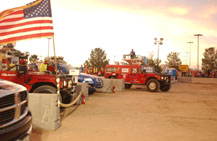|
What is the Urban Challenge?

The DARPA Urban Challenge is an autonomous vehicle research and development
program with the goal of developing technology that will keep warfighters off
the battlefield and out of harm’s way. The Urban Challenge features autonomous
ground vehicles maneuvering in a mock city environment, executing simulated
military supply missions while merging into moving traffic, navigating traffic
circles, negotiating busy intersections, and avoiding obstacles.
The program is conducted as a series of qualification steps leading to a
competitive final event, scheduled to take place on November 3, 2007, in
Victorville, California. DARPA is offering $2M for the fastest qualifying vehicle, and $1M
and $500,000 for second and third place.
This program is an outgrowth of two previous DARPA Grand Challenge autonomous
vehicle competitions. The first Grand Challenge event was held in March 2004 and
featured a 142-mile desert course. Fifteen autonomous ground vehicles attempted
the course and no vehicle finished. In the 2005 Grand Challenge, four autonomous
vehicles successfully completed a 132-mile desert route under the required
10-hour limit, and DARPA awarded a $2 million prize to “Stanley” from Stanford
University.
Grand Challenge 2004 Website
Grand Challenge 2005 Website
Grand Challenge 2005 Tracking Site
Grand Challenge 2005 Report to Congress
Urban Challenge 2007 Prize Report
What is an autonomous ground vehicle?
An autonomous ground vehicle is a vehicle that navigates and drives entirely on
its own with no human driver and no remote control. Through the use of various
sensors and positioning systems, the vehicle determines all the characteristics
of its environment required to enable it to carry out the task it has been
assigned.
Why develop autonomous vehicles?
The National Defense Authorization Act for Fiscal Year 2001, Public Law 106-398, Congress mandated in Section 220 that “It shall be a goal of the Armed Forces to achieve the fielding of unmanned, remotely controlled technology such that… by 2015, one-third of the operational ground combat vehicles are unmanned.” DARPA conducts the Urban Challenge program in support of this Congressional mandate. Every “dull, dirty, or dangerous” task that can be carried out using a machine instead of a human protects our warfighters and allows valuable human resources to be used more effectively.
Who are the teams?
The Urban Challenge teams come from across the United States and around the
world, and share a passion for the advancement of robotic technology and machine
intelligence. This diverse group includes teams from both academia and the
robotics, automotive, and defense industries. Some teams are affiliated with
organizations, others are groups of volunteers who have come together
specifically for the challenge. Each is working to develop a vehicle to complete
the 60-mile urban course in less than six hours. Please visit the
Teams page for
more information.
What are Tracks A and B?
When the Urban Challenge kicked off, DARPA announced an opportunity for teams to receive funding in amounts up to $1M to develop their autonomous vehicle. Sixty-five proposals were reviewed and evaluated, and 11 recipients were announced. “Track A” refers to the teams that were selected to receive funding. All teams compete on an equal footing to participate in the Urban Challenge.
How does a team apply to participate in the Urban Challenge?
The application period closed in October 2006.
Team leaders applied to participate more than one year before the event by
providing DARPA with basic information on their teams and vehicles. From this
point, teams underwent a rigorous evaluation and qualification process:
demonstration videos were due in April 2007, technical papers were due in June
2007, and site visit tests were conducted in July 2007. Teams that were successful
were invited to participate in the National Qualification Event on October 26-31
2007, where they competed for the chance to participate in the Urban
Challenge Final Event on November 3, 2007.
Eleven of the 89 teams participating, the “Track A” teams, applied for and
received seed funding for development of their vehicle. The 78 “Track B” teams
are entirely self-supported.
More Information
Building the Best Driverless Robot Car
"Time Magazine," November 15, 2007
No Drivers, but a Lot of Drive
'The New York Times," November 11, 2007
Robots Meet Reality
"Forbes.com," November 11, 2007
SUV
with mind of its own wins robot car race
"Reuters," November 4, 2007
Move
Over, the Robot's Driving
"ABC News," November 6, 2007
Carnegie
Mellon Robotized SUV Wins DARPA Urban Challenge
"ScienceDaily," November 6, 2007
DARPA Grand Challenge Wikipedia entry
|











